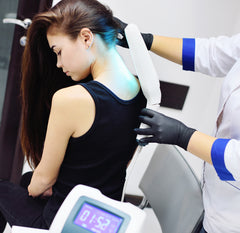
If you’re among the 8 million Americans that are affected by psoriasis [Study], you may be wondering if light therapy actually works for your condition or is just another hyped up—yet ineffective—treatment.
The truth is, there’s no one-size-fits-all medication or modality for psoriasis, but red light therapy for psoriasis just might be as close as we can get.
That’s because it works not just to reduce symptoms, but also to improve cellular function, so your skin can fight redness, and become blemish-free naturally.
In a moment, we’ll discuss photo-, and red light therapy in-depth, but first, let’s review standard, conventional treatments, so we have an accurate basis for comparison.
Conventional Psoriasis Treatments
Currently, there is no cure for psoriasis, so the main objective of treatments is to encourage remission and restore a healthy and normal skin surface.
Over-the-counter and prescription treatments include topical, oral, and injected medication, including:
OTC and prescription, topical creams and ointments, for mild to moderate psoriasis. These include corticosteriods, Vitamin D, Anthralin, retinoids, calcineurin inhibitors, salicylic acid, coal tar, and moisturizers.
Oral or injected medication: retinoids, methotrexate, cyclosporine, immune-altering biologics, Thioguanine, and others.
Aloe vera, fish oil, Vitamin E oil and Oregon Grape are home remedies that may ease mild psoriasis symptoms.
Each of these treatments can—and do—work for some patients, but they’re also often inconsistent, and even completely ineffective. To make matters worse, topical treatments can have side effects including allergic reactions, and are not effective on severe psoriasis.
Also, oral psoriasis medications especially may have severe side effects, and must be used with extreme caution.
Together, the ineffectiveness and potential side affects leave many patients looking for an alternative. And that’s where light therapy—or phototherapy—comes in.
Note: If you have psoriasis, it goes without saying that you should talk to a doctor before receiving any sort of treatment.
Phototherapy (Light Therapy) for Psoriasis

In phototherapy, the skin is exposed to sunlight or artificial UVA and UVB light, alone or in combination with other treatments. Delivered by a dermatologist via a tanning-booth-style unit or smaller LED panels, artificial UVA and UVB light penetrates into the uppermost layers of the skin to slow skin cell growth and reduce scaling, itching and inflammation.
UVA and UVB can be used together, separately, or with a variety of other medications and modalities to provide the best results. Here are the standard options:
Narrowband UVB
If you have to select one type of UV light alone to treat psoriasis, narrowband UVB is the most effective option. “Narrowband” simply means a select few wavelengths are isolated from the broader UVB spectrum, which are known to give the best results. Unfortunately, the treatment also comes with an elevated risk of burns.
Psoralen Plus UVA (PUVA)
This treatment option uses light-sensitizing medication (psoralen) administered prior to UVA exposure to allow better absorption and deeper penetration into the skin.
Goeckerman Therapy
Goeckerman therapy combines UVB light treatment with a coal tar application beforehand to make the skin more receptive and improve results.
Excimer Lasers
This technology allows technicians to use an extremely targeted UVB light to treat affected skin without harming healthy, surrounding tissue.
Regardless of the specific modality or combination you choose, UVA/UVB light therapy usually works extremely well. But it often comes with side effects including burns, redness, and blistering. The biggest issue is that these wavelengths have the same drawbacks of extended sun exposure. Specifically, if they’re used for prolonged periods, the can lead to accelerated skin aging and even melanoma.
Treatment also requires a significant commitment to a several-month-long course of phototherapy that involves multiple sessions per week. Once symptoms abate, the frequency of treatments can be reduced to 1-2 times per week to prevent recurring psoriasis flares. Still, light therapy is arguably the most effective conventional treatment for psoriasis.
Is Red Light Therapy Good for Psoriasis?
Since the increased risk of skin damage and cancer is a concern with UVA and UVB phototherapy—and because topical, light, or oral therapies don’t offer consistent or permanent relief—it’s worth looking into red light therapy as a promising and effective alternative.
Red light therapy--also called low-level laser light therapy (LLLT)—involves exposing the skin to relatively long wavelengths of light (630-700nm) which penetrate the skin to about 8-10mm (⅓ inch).
In contrast, UVA and UVB light do not penetrate the skin as deeply, due to their shorter wavelengths (215-400nm). The longer wavelengths inherent in red light help it promote healing without the side effects of UVA and UVB.
So almost non-existent side effects of light therapy for psoriasis are a big reason why more and more people are turning to red light therapy for skin conditions such as psoriasis, wrinkles, and many more.
How Red Light Therapy Helps Psoriasis
By penetrating deep into the skin, red light promotes skin health in several ways:
- Red light stimulates the production of new capillaries, which increases the delivery of nutrients and oxygen to the skin.
- Red light stimulates the lymphatic system, which makes waste removal more efficient and results in healthier skin that is less prone to psoriasis flares.
- Psoriasis and other autoimmune disorders interfere with collagen production. Collagen is a protein that gives skin a firm, supple, and full appearance. Red light stimulates collagen production which can help soothe the skin and reduce flares.
- Most notably, red light stimulates the production of adenosine triphosphate (ATP) from the cells’ mitochondria. This is the cells’ energy source. A cell that has more energy has more capabilities to perform its normal functions, as well as regeneration and self-healing. Researchers found that ATP reduces inflammation that can lead to the main symptom of psoriasis: abnormally rapid replication of skin cells.
Psoriasis causes cells to replicate at 10x the normal rate, which outpaces the body’s ability to shed them (as normal skin cells are shed when they die); this results in those unsightly red, scaly, painful and itchy areas.
Since light therapy helps to restore normal cell function, this means that the rate of growth will normalize and you’ll experience fewer and less intense flares.
All types of phototherapy require several treatments per week for several months (depending on the severity of the condition), plus ongoing maintenance treatments.
Due to this intensive time commitment, it might be nice to know that you can treat psoriasis at home using high-quality LED panels.
LED Light Therapy for Psoriasis: Treatment at Home
Red light therapy for psoriasis at home treatment follows the same protocol as you'd see in a clinic as performed by a dermatologist. Treatment begins with short 2-5 minute sessions to determine your skin’s sensitivity to the treatment. In some cases, red light can cause temporary mild redness and feelings of tightness, but it won’t burn the skin like UVA/UVB lights.
Regular psoriasis light therapy treatment begins with 3-5 sessions per week for the first month, with each session lasting from 5-15 minutes. During the next 1-3 months, the number of treatments is reduced to 2-3 times per week.
Once the initial treatment is complete and your psoriasis is in remission, continue with 1-2 maintenance treatments per week to prevent flares.
Depending on the severity of your psoriasis, you may see results within a few treatments, but severe cases will require more time. Maintenance treatments are important, since red light can reduce symptoms, but isn’t considered a full cure.
When choosing a home device, the most important factor to consider is the wavelengths emitted as well as the intensity of light output: low-powered red light wands and masks, which can have as little as 12 watts of output, do not deliver nearly enough intensity to have much therapeutic value.
For psoriasis, a device that delivers high-intensity red light (125-400 watts) via light-emitting diodes (LED) lets you target flares anywhere on your body.
It’s also interesting to note that red light therapy has other uses besides easing the symptoms of psoriasis: it can also reduce the effects of aging; treat acne, eczema and rosacea; reduce the appearance of stretch marks and scars; and to generally improve the health of the skin, which is the body’s largest organ.
This makes investing in a quality LED panel a great choice for overall skin care.
You could check these alternate Home Remedies for Psoriasis out.
Red Light Therapy: Effective, If You’re Consistent
Red light therapy can be effective for treating psoriasis by stimulating the body’s own healing mechanisms and helping restore skin health at the cellular level.
Using it also comes with a variety of secondary benefits, including improved skin health and appearance overall.
The only downside is that you need to commit to consistent treatments, and a bit of time may be required before seeing dramatic results.
Research into red light therapy for psoriasis is still limited, but it shows great promise “due to its strong penetration and encouraging photomodulation.” All together, the skin-regenerating benefits and lack of side effects may make red light therapy the best treatment option for psoriasis available today.
The BIOMAX Series are the most advanced consumer red light therapy panels on the market.
Meanwhile, the SaunaMAX Pro has all the features of the BIOMAX Series, but can be used for in-sauna treatment. It's the ideal panel for red light therapy users who also have a home sauna.
Frequently Asked Questions
Q. Do tanning beds or sunbeds help with psoriasis?
Ans: No, they are hardly effective and there are always risks involved. Also, it is not recommended by "The National Psoriasis Foundation". UV light therapy can be used only if your dermatologist prescribes it, where the strength and dose of UV are controlled with caution.
Q. Is red light therapy for psoriasis covered by insurance?
Ans: It is less likely that insurance will cover light therapy for home treatment, however, some insurance might cover light therapies as a treatment of psoriasis and eczema, only when the conventional methods of treatments did not work.



